Care of Bareroot
What should I be doing with my fruit trees in the winter?
Winter is coming
What should I be doing with my fruit trees in the winter?
Winter time is a great time to do work on your trees. Short days and cool temperatures cause your fruit trees go dormant in the winter. Dormant means the tree's metabolism has shut down and can be worked without stressing the plant. Here is a work check list:
1. Don't Water. Shut off the water in early November. Do not turn it back on until buds break and leaf out in March. Dormant trees do not have the ability to take on nutrients and water. Too much water just dissolves away vital sugars being stored in roots for the next season's growth and sets the stage for root and soil borne diseases. Normal winter rains will carry minimum moisture needed through the season. No rainfall may require a check for moisture and infrequent irrigation.
2. Fertilizer: N-P-K. You should not apply (N) nitrogen in the fall. Nitrogen could cause a delay in the dormancy process, causing the soft tissue to be damaged by frost. Once dormant, the trees will not use nitrogen during the winter and it will likely be gone by spring. (P) Phosphorus and (K) Potassium stay in the soil and do provide benefit of cold hardiness and root development. P and K are available organically in potash, hardwood ash and kelp products. Or you can just wait until spring and use a complete fertilizer like 12-12-12. Rates differ, check with your local extension agent or farm advisor.
3. Prune. Winter is a great time to prune. Remove all suckers and water sprouts (tall shoots with no side branches). Open center up to let light and air in during growing season. Work on developing the scaffold branches that grow the fruiting spurs. Pruning tar or paint delays healing process and is not recommended.
4. Spray. For protection against insects and fungus, I recommend a dormant spray program. There are many formulations on the market including some for organic use. Read your labels; it should have a dormant oil and copper and possibly sulfur in it. I do not have a pesticide applicator license for your area so I cannot make specific recommendations; just point you in the right direction. Remember, always use sprays according to the label! No exceptions. Once again, check with your county agents and farm advisors
5. Plant. When the trees are asleep it is the perfect time to plant and/or dig. If you need to lift up or move a tree; this is also the time. That is why we (L.E. Cooke) deliver your -trees during the winter. The rules in #1 apply to your new trees. Water in one time; do not water again until leaf opens fully. Overwatering is the most common reason for tree failure. Too much water is wasteful. Too much water hurts the trees.
Tom Fetch 10/21/15
L.E. Cooke Co.
Fire Blight Control
Frequently we get requests for how to control Fire Blight.

Fire Blight in Apple Tree (Wiki Creative Commons - photo bySebastian Stabinger)
A) Fire Blight Resistance:
In Fire Blight prone areas, where possible, select varieties that are more resistant to Fire Blight. For example, the Pears in our catalog are shown with a Fire Blight resistant rating. There are varieties that never get Fire Blight in our observations and others that rarely show much effect. On the other hand, we are convinced that there are different strains of Fire Blight across the country so there is no guarantee that something we observe to be resistant might not get it somewhere else. As we learn about issues in other places, we adjust the ratings.
B) Environmental Cleanliness. See the links below for what University of California and Cornell University has to say. No need to duplicate it here.
C) Chemical Controls:
1) We cannot give you advice on chemical controls. That is the responsibility of your local PCA. And each state has different products registered for use in the state. In addition, home owners have far fewer choices than licensed applicators or nurseries have.
2) This is what we have been doing as of this writing for our production fields and budwood orchards in Visalia, California. Remember - this is not advice on what you can do - you must check with your local authorities and state regulations. This is what we, as a licensed and skilled nursery can do in our part of California with the products registered as of the time of this writing and not what a homeowner can do.
When we do get Fire Blight in a crop or two, our treatment regime is Agri-Mycin, a bactericide control agent, Allete, and then a copper spray, generally Kocide here. When it gets real hot, like around 95 or better, we stop the Kocide rotation as it can burn.
First thing to do is cut the plant back to green, uninfected wood, removing the infected wood from the area immediately. Burn if possible. Then apply the chemicals to the entire plant, especially the open wounds to help stop reinfection if the bacteria is still present. We spray in the rotation every 10-15 days until the threat of reinfection is over. Here, that means no rain for 3 weeks or better and normal humidity, which is low.
If it rains again, we auto start the rotation, on the sensitive plants (like Quince and some crabapples) without waiting for infection. If you wait to see it before you treat the young, sensitive trees, you won't have them be alive later. The mature trees, we would probably wait until seeing a strike unless you know the history of the plant in that area.
Hope this is helpful to get an idea, but do the due diligence for your location.
University of California Integrated Pest Management System page on Fire Blight
http://www.ipm.ucdavis.edu/PMG/PESTNOTES/pn7414.html
Cornell University Integrated Pest Management System page on Fire Blight
http://www.nysipm.cornell.edu/factsheets/treefruit/diseases/fb/fb.asp
6-28-2013
Pomegranates - Pruning for Transplant Survival
Pomegranates provide wonderful fruit for fresh eating, juices for drinking or making great jelly and an attractive ornamental summer bloom. We want our customers to be successful when receiving and planting the bareroot pomegranates.
Bareroot transplanting of these bushes and trees will be highly successful if you follow two simple rules: Prune them for survival (picture it like a dormant rose pruning) and control over-watering until in leaf.
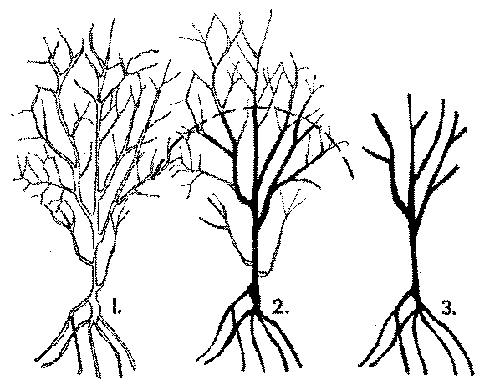
Pomegranate Pruning Sketch - Prune like a Dormant Rose
Experienced nurseries have learned that they will have a nearly 100% success rate if the bareroot Pomegranates are pruned heavily when planted or they will have a high mortality rate if they don't. This is true whether you are in a dry climate or not.
Why? Most dormant trees do not need water when there are no leaves because internal moisture is not exchanged with the atmosphere without the leaves and photosynthesis. This is why trees can be dug and shipped bareroot when the leaves are gone. Usually the delicate feeder roots are re-established to take up moisture by the time new leaves form.
Certain trees and shrubs have very fine and delicate branching structures like the Elms, Zelkova and Pomegranates which will continue to give away moisture to the environment and these branches need to be removed to prevent dessication. Until the delicate feeder roots can re-grow, the tree cannot take up more water. Hard pruning gives the tree a chance to not desiccate while the new roots develop.
The new roots grow best in a soil media that is damp but not saturated with water.
The nice thing about Pomegranates, once the roots get re-established, it will re-grow rapidly. If you try to preserve too much of the original bushy top, the bush or tree will struggle at best or perish. Prune it hard and you will be satisfied with the results.
See our brief video: Pomegranate Pruning for Transplant Survival
Here are some printable .pdf pages for employee training:
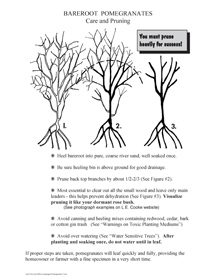
Pomegranate Pruning Storyboard
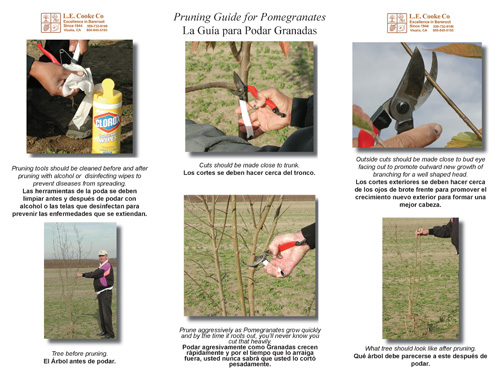
Elms-Hackberry-Zelkova-Pruning-For-Transplant-Survival
Elms, Hackberry and Zelkova are some of the most popular landscape trees. Lacebark Elms (Ulmus parvifolia) and other species crossed with U. parvifolia have exploded on the scene with their attractive exfoliating bark and delicate filtered shade. Zelkova are planted likewise because of the Elm-like appearance. Hackberries are stately trees used in large landscapes or street trees.
Bareroot transplanting of these trees will be highly successful if you follow two simple rules: Prune them for survival and control over-watering until in leaf.
Experienced nurseries have learned that they will have a nearly 100% success rate if the bareroot Elms or Zelkova are pruned heavily when planted or they will have a high mortality rate if they don't. This is especially true for the nurseries in desert like dry climates where dessication is always an issue.
Why? Most dormant trees do not need water when there are no leaves because internal moisture is not exchanged with the atmosphere without the leaves and photosynthesis. This is why trees can be dug and shipped bareroot when the leaves are gone. Usually the delicate feeder roots are re-established to take up moisture by the time new leaves form.
Certain trees and shrubs have very fine and delicate branching structures like the Elms, Zelkova and Pomegranates which will continue to give away moisture to the environment and these branches need to be removed to prevent dessication. Until the delicate feeder roots can re-grow, the tree cannot take up more water.
Hard pruning give the tree a chance to not desiccate while the new roots develop. The new roots grow best in a soil media that is damp but not saturated with water.
The nice thing about Elms and Zelkova, once the roots get re-established, the trees grow rapidly and put on a beautiful canopy. If you try to preserve too much of the original canopy, the tree will struggle at best or perish. Prune it hard and you will be satisfied with the results.
Here are some pages which can be printed out for employees (Storyboards are bilingual):
Pruning Elms, Hackberries & Zelkova
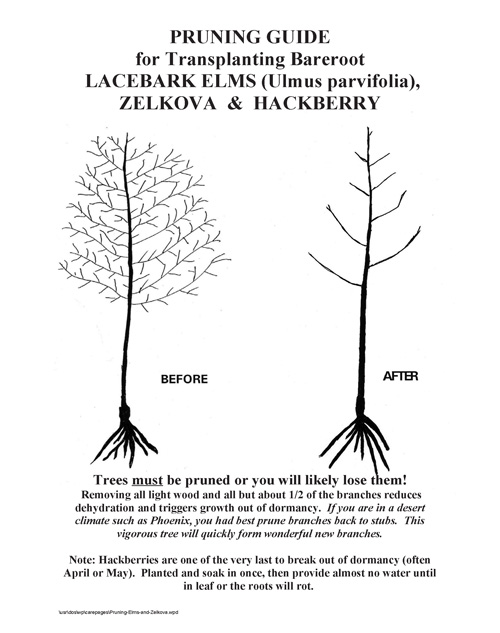
Elm Pruning Storyboard - No Central Leader (English & Spanish)
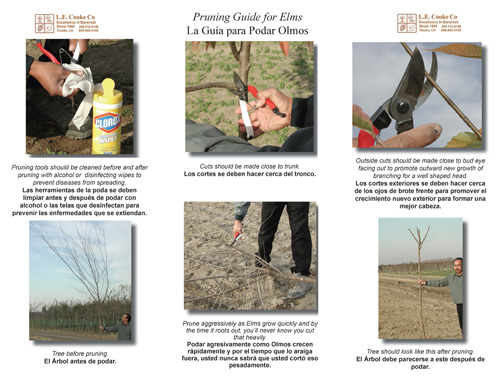
Elm Pruning Storyboard - Central Leader (English & Spanish)
Zelkova Pruning Storyboard (English & Spanish)
Tree & Plant Care Info for Growers & Homeowners
Disclaimer: This information is general in nature and may not apply to all situations as climates, site conditions and soil types can vary greatly from one location to another. We highly recommend that you contact your local retail nursery for their expertise in selection and care of trees and plants for your local environment. Farmers should be working closely with their local or regional farm advisors or University Extension agents. These local experts will be more familiar with your local environment than we can sitting here in our own Garden of Eden.
There are NO recommendations or advice on pesticide sprays or other chemical applications on this website. Every state has different licenses and requirements and different pests (insects, not bureaucrats ). Contact your local PCA (Pest Control Advisor) or retail nursery for the pests and products legally available to use on them in your location.
). Contact your local PCA (Pest Control Advisor) or retail nursery for the pests and products legally available to use on them in your location.
This page is always a work in progress. You can never have too much information! Links will be added when pages or videos are completed.
PLANTING TOPICS
Planting A Tree (in the Ground)
Watering Trees
Asian Pear Small Farm Production - University of California Cooperative Extension
Planting & Growing Blackberries
Tips for Successful Walnut Replanting
PRUNING TOPICS
Fruit Tree Pruning Basics - University of California Cooperative Extension
Fruit Tree Pruning - U.C. Davis Publication 8057
Training & Pruning Your Home Orchard - Oregon State University - Pacific Northwest Extension
Pruning Blackberries and Raspberries - Cornell University Cooperative Extension
Pruning Grapevines - Spur vs Cane - PDF page with links to more detailed information
Pruning Grapevines - Encouraging article from experts at National Gardening Association
Pruning Lilacs - Fine Gardening
Pruning of all kinds - the what and why - by The Backyard Boss
OTHER TOPICS & RESOURCES
What Should I Be Doing With My Fruit Trees In the Winter?
Growing Table Grapes - Oregon State University guide for the homeowner and small orchardist.
Urban Tree Foundation Cue Cards
(Tree Quality, Tree Planting, Tree Training, Root Management)

